I'm trying to create checkbox, frame, and grid layout objects and store them in their own list.
The output from Qt Designer looks like: 
Essentially, I want to create Checkbox1, then create a frame and grid layout to store Checkbox2 and Checkbox3.
My approach was to first create an empty list to store the objects I'm creating:
checkboxList = []
Then to append it with a call to create the appropriate object checkboxList.append(CreateCheckBox(self.frame_main, self.gridLayout_main, 0, 'Checkbox 1') (for example)
The frame I created isn't visible! I'm guessing there are a few possible reasons for this:
- I'm creating the classes incorrectly
- I'm storing the objects I created incorrectly (i.e. init doesn't return anything so I'm not actually storing anything?)
- I'm not adding my objects to the main frame properly so they're not showing up
Why isn't my class implementation working like the code from Qt Designer and what/how do I make the changes to get a similar output?
The code imported from Qt Designer looks like this:
from PySide import QtCore, QtGui
class Ui_MainWindow(object):
def setupUi(self, MainWindow):
MainWindow.setObjectName("MainWindow")
MainWindow.resize(494, 210)
self.centralwidget = QtGui.QWidget(MainWindow)
self.centralwidget.setObjectName("centralwidget")
self.frame_main = QtGui.QFrame(self.centralwidget)
self.frame_main.setGeometry(QtCore.QRect(20, 10, 435, 141))
self.frame_main.setFrameShape(QtGui.QFrame.StyledPanel)
self.frame_main.setFrameShadow(QtGui.QFrame.Raised)
self.frame_main.setObjectName("frame_main")
self.gridLayout_2 = QtGui.QGridLayout(self.frame_main)
self.gridLayout_2.setContentsMargins(0, 0, 0, 0)
self.gridLayout_2.setSpacing(0)
self.gridLayout_2.setObjectName("gridLayout_2")
self.gridLayout_main = QtGui.QGridLayout()
self.gridLayout_main.setSpacing(0)
self.gridLayout_main.setObjectName("gridLayout_main")
self.frame2 = QtGui.QFrame(self.frame_main)
self.frame2.setFrameShape(QtGui.QFrame.StyledPanel)
self.frame2.setFrameShadow(QtGui.QFrame.Raised)
self.frame2.setObjectName("frame2")
self.gridLayout_16 = QtGui.QGridLayout(self.frame2)
self.gridLayout_16.setContentsMargins(0, 0, 0, 0)
self.gridLayout_16.setObjectName("gridLayout_16")
self.gridLayout2 = QtGui.QGridLayout()
self.gridLayout2.setObjectName("gridLayout2")
spacerItem = QtGui.QSpacerItem(40, 20, QtGui.QSizePolicy.Fixed, QtGui.QSizePolicy.Minimum)
self.gridLayout2.addItem(spacerItem, 0, 0, 1, 1)
self.checkBox2 = QtGui.QCheckBox(self.frame2)
self.checkBox2.setObjectName("checkBox2")
self.gridLayout2.addWidget(self.checkBox2, 0, 1, 1, 1)
self.checkBox3 = QtGui.QCheckBox(self.frame2)
self.checkBox3.setObjectName("checkBox3")
self.gridLayout2.addWidget(self.checkBox3, 1, 1, 1, 1)
self.gridLayout_16.addLayout(self.gridLayout2, 0, 0, 1, 1)
self.gridLayout_main.addWidget(self.frame2, 1, 1, 1, 1)
self.checkBox1 = QtGui.QCheckBox(self.frame_main)
self.checkBox1.setObjectName("checkBox1")
self.gridLayout_main.addWidget(self.checkBox1, 0, 1, 1, 1)
spacerItem1 = QtGui.QSpacerItem(50, 20, QtGui.QSizePolicy.Fixed, QtGui.QSizePolicy.Minimum)
self.gridLayout_main.addItem(spacerItem1, 0, 0, 1, 1)
self.gridLayout_2.addLayout(self.gridLayout_main, 0, 0, 1, 1)
MainWindow.setCentralWidget(self.centralwidget)
self.menubar = QtGui.QMenuBar(MainWindow)
self.menubar.setGeometry(QtCore.QRect(0, 0, 494, 21))
self.menubar.setObjectName("menubar")
MainWindow.setMenuBar(self.menubar)
self.statusbar = QtGui.QStatusBar(MainWindow)
self.statusbar.setObjectName("statusbar")
MainWindow.setStatusBar(self.statusbar)
self.retranslateUi(MainWindow)
QtCore.QMetaObject.connectSlotsByName(MainWindow)
def retranslateUi(self, MainWindow):
MainWindow.setWindowTitle(QtGui.QApplication.translate("MainWindow", "MainWindow", None, QtGui.QApplication.UnicodeUTF8))
self.checkBox2.setText(QtGui.QApplication.translate("MainWindow", "Checkbox2", None, QtGui.QApplication.UnicodeUTF8))
self.checkBox3.setText(QtGui.QApplication.translate("MainWindow", "Checkbox3", None, QtGui.QApplication.UnicodeUTF8))
self.checkBox1.setText(QtGui.QApplication.translate("MainWindow", "Checkbox1", None, QtGui.QApplication.UnicodeUTF8))
if __name__ == "__main__":
import sys
app = QtGui.QApplication(sys.argv)
MainWindow = QtGui.QMainWindow()
ui = Ui_MainWindow()
ui.setupUi(MainWindow)
MainWindow.show()
sys.exit(app.exec_())
And my code with classes looks like:
from PySide import QtCore, QtGui
class CreateCheckBox(QtGui.QCheckBox):
def __init__(self, frame, grid, gridLoc, name, parent=None):
#QtGui.QCheckBox.__init__(self, parent=parent) Is this the same as the super below?
super(CreateCheckBox, self).__init__(parent)
self.checkbox = QtGui.QCheckBox(frame)
grid.addWidget(self.checkbox, gridLoc, 2, 1, 1)
self.checkbox.setText(name)
class CreateFrame(QtGui.QFrame):
def __init__(self, parentFrame, parentGridLayout, gridLoc, parent=None):
#QtGui.QFrame.__init__(self, parent=parent) Is this the same as the super below?
super(CreateFrame, self).__init__(parent)
self.frame = QtGui.QFrame(parentFrame)
self.frame.setFrameShape(QtGui.QFrame.StyledPanel)
self.frame.setFrameShadow(QtGui.QFrame.Raised)
parentGridLayout.addWidget(self.frame, gridLoc, 2, 1, 1)
class CreateGridLayout(QtGui.QGridLayout):
def __init__(self, parentFrame, parent=None):
super(CreateGridLayout, self).__init__(parent)
#QtGui.QGridLayout.__init__(self) # This line throws an error if I include parent=parent, why?..
self.gridLayoutSecondary = QtGui.QGridLayout(parentFrame)
self.gridLayoutSecondary.setContentsMargins(0, 0, 0, 0)
self.gridLayoutPrimary = QtGui.QGridLayout()
spacerItem = QtGui.QSpacerItem(40, 20, QtGui.QSizePolicy.Fixed, QtGui.QSizePolicy.Minimum)
self.gridLayoutPrimary.addItem(spacerItem, 0, 0, 1, 1)
self.gridLayoutSecondary.addLayout(self.gridLayoutPrimary, 0, 0, 1, 1)
class Ui_MainWindow(object):
def setupUi(self, MainWindow):
MainWindow.setObjectName("MainWindow")
MainWindow.resize(494, 210)
self.centralwidget = QtGui.QWidget(MainWindow)
self.centralwidget.setObjectName("centralwidget")
self.frame_main = QtGui.QFrame(self.centralwidget)
self.frame_main.setGeometry(QtCore.QRect(20, 10, 435, 141))
self.frame_main.setFrameShape(QtGui.QFrame.StyledPanel)
self.frame_main.setFrameShadow(QtGui.QFrame.Raised)
self.frame_main.setObjectName("frame_main")
self.gridLayout_main = QtGui.QGridLayout()
self.gridLayout_main.setSpacing(0)
self.gridLayout_main.setObjectName("gridLayout_main")
spacerItem1 = QtGui.QSpacerItem(50, 20, QtGui.QSizePolicy.Fixed, QtGui.QSizePolicy.Minimum)
self.gridLayout_main.addItem(spacerItem1, 0, 0, 1, 1)
MainWindow.setCentralWidget(self.centralwidget)
self.menubar = QtGui.QMenuBar(MainWindow)
self.menubar.setGeometry(QtCore.QRect(0, 0, 494, 21))
self.menubar.setObjectName("menubar")
MainWindow.setMenuBar(self.menubar)
self.statusbar = QtGui.QStatusBar(MainWindow)
self.statusbar.setObjectName("statusbar")
MainWindow.setStatusBar(self.statusbar)
# List that contains new checkboxes
checkboxList = []
# List that contains new frames
frameList = []
# List than contains grid layouts for new frames
gridLayoutList = []
# Create 'checkBox1'
checkboxList.append(CreateCheckBox(self.frame_main, self.gridLayout_main, 0, 'Checkbox 1'))
# Create 'frame2'
frameList.append(CreateFrame(self.frame_main, self.gridLayout_main, 1))
# Create 'gridLayout2'
gridLayoutList.append(CreateGridLayout(frameList[0]))
# Create 'checkBox2'
checkboxList.append(CreateCheckBox(frameList[0], gridLayoutList[0], 0, 'Checkbox 2'))
# Create 'checkBox3'
checkboxList.append(CreateCheckBox(frameList[0], gridLayoutList[0], 1, 'Checkbox 3'))
self.retranslateUi(MainWindow)
QtCore.QMetaObject.connectSlotsByName(MainWindow)
def retranslateUi(self, MainWindow):
MainWindow.setWindowTitle(QtGui.QApplication.translate("MainWindow", "MainWindow", None, QtGui.QApplication.UnicodeUTF8))
if __name__ == "__main__":
import sys
app = QtGui.QApplication(sys.argv)
MainWindow = QtGui.QMainWindow()
ui = Ui_MainWindow()
ui.setupUi(MainWindow)
MainWindow.show()
sys.exit(app.exec_())



